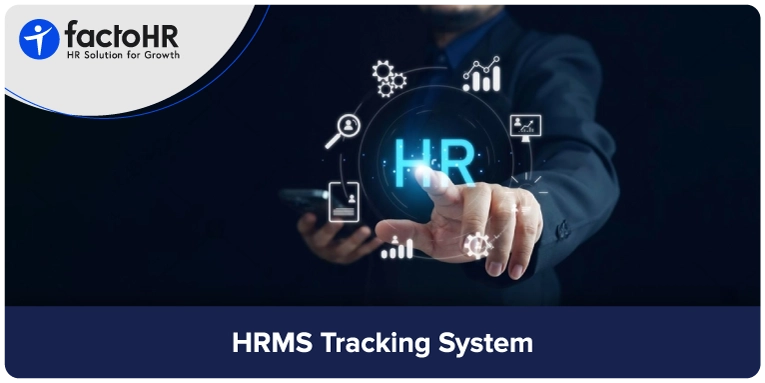HRMS Tracking System: Meaning & Definition

Table of Contents
Businesses constantly seek methods to get the most out of their staff while staying ahead of the competition. Real-time performance tracking via an HRMS tracking system is a complete game changer. This approach revolutionizes traditional performance management by continuously collecting and analyzing performance data.
Tracking and monitoring employee attendance and performance is critical for businesses to maintain productivity and ensure successful workforce management. A Human Resource Management System (HRMS) can help companies track and monitor employee absences, improving the leave management process and increasing overall efficiency. This article will examine how HRMS may be used to track and monitor employee absences.
What Is the HRMS Tracking System?
HRMS is a digital tool businesses use to track and manage staff activities such as attendance, task duration, productivity, project progress, and, on occasion, location. It uses software for time tracking, work location, and project management. These tools help collect and analyze data on staff performance and work habits. The primary goal is to streamline personnel management, increase efficiency, assure policy adherence, and raise production levels.
Real-time tracking makes it easier to define clear, measurable goals directly related to the company’s objectives. Managers and employees can see in real-time if they are on track or falling behind, allowing them to make course corrections before it is too late. That type of alignment is crucial for ensuring everyone is rowing in the same direction.
Thus, HRMS in India is about software programs that help HR practitioners handle HR functions effectively. An HR management system uses digital automation to organize and display candidate and staff data. The software prioritizes convenience, allowing real-time updates when users input information.

Importance of HRMS Tool
An HRM system empowers workers, relieves administrative burdens, improves employee management methods, centralizes critical HR data, and improves employee communication. According to G2.com data, 95% of professionals use technology to manage their work. This is why it is important to start using HR management systems in your organization.
- An HR management system with self-service options enables your employees to track and manage their tasks. This increases their autonomy and decreases their reliance on the HR department.
- HR management automation allows you to record information for onboarding, time spent off, payroll, efficiency, and more in a single, centralized database. Individuals can only access this data with the necessary authorization, ensuring data security, employee privacy, and audit compliance.
- HR administration system provides access to an internal chat system, allowing for easy communication among your staff.
- HR systems improve how your firm manages its employees by providing them with a convenient and personalized working environment.
- Manually managing HR processes raises your HR department’s administrative burden. This translates to more hours spent on administrative activities rather than other strategic measures to improve labor management.
Features of Human Resource Management Tracking System
Time Tracking
It is a key feature of the HR Management System, which includes features for measuring working hours, controlling productivity, and creating analytical reports.
Attendance Monitoring
It is usually a constant issue for HR departments, particularly with the development of remote employment. Traditional approaches are prone to inaccuracies and time theft. However, comprehensive attendance monitoring software integrated into an HRM system addresses these difficulties.
Performance Tracking and Management
Look for features that allow you to effectively record overall goals related to specific tasks and appropriate milestones that signal progress. Performance management modules are commonly found in the top tools and software for implementing this feature.
Employee Dashboard
Employee self-service improves simplicity of usage. The feature gives employees access to specific software portals to alter and enter information about their work.
Notification Reminders
Notification reminders help track performance and progress. It can access work at any moment and make the necessary modifications to guarantee that a job in progress is on track.
Accurate Data Reporting
The HR system enables employee self-service, analyzes work hours and performance, and progressively collects data.
Payroll Management
The system’s professional tools and features effectively manage compensation and benefits, including salary allowances and overtime rates. To streamline the process, payroll, the most complex duty in the HR department, will be automated.
Flexibility
The appropriate tools should be accessible from multiple devices, swift, and work with various operating systems.

Benefits of an HRM Tracking System
Real-time Attendance Tracking
Real-time absence tracking and following the attendance policy are critical for sustaining productivity and effective staff management. Human resource management systems enable firms to track absenteeism in real-time, allowing management to spot patterns or trends immediately and solve any concerns before they arise. Real-time tracking guarantees that leave data is always accurate and current, allowing for better decision-making and communication among employees and management.
Automated Leave Application and Approval System
The HR management system simplifies the leave request and approval process, allowing employees to request time off and managers to examine and approve requests. The system can be set to enforce leave policies and ensure that requests follow applicable rules and regulations. This automation decreases the administrative burden on HR workers and managers while ensuring consistency in the administration of leave policy.
Improved Employee Performance
Real-time performance tracking instills a sense of ownership and accountability in employees. When people can see the immediate results of their work in crucial KPIs, they become more involved and inspired to succeed. HR tools may increase engagement by introducing gamification elements like achievement bars, leaderboards, and reward tools, making performance tracking a rewarding and exciting experience.
Improved Feedback and Coaching
Real-time tracking enables managers to deliver targeted feedback and coaching as performance concerns or achievements arise. Instead of waiting for formal review cycles, managers can immediately target areas for improvement or recognize exceptional performance. This continual feedback loop supports a culture of learning and development within the firm, allowing employees to hone their talents and reach their potential.
Optimized Goal Alignment
Practical goal setting is critical to organizational success. HRMS’s real-time tracking features enable the formulation of goals matched with individual and organizational objectives. Managers and employees can detect barriers or deviations early on when they track progress against these targets in real time. This enables course correction, ensuring everyone remains engaged and working toward the same strategic goal.
Factual Basis for Performance Assessments
Traditional performance assessments frequently rely on subjective impressions and memories, which can lead to biases and errors. Managers can use real-time tracking to provide performance evaluations based on objective data obtained throughout the evaluation period. This data-driven method assures that performance evaluations are honest, reliable, and based on measurable results.
Effective Task Management and Incentive Programs
Integrating geo-tracking and HR tools allows efficient task assignments based on real-time position data. This function guarantees that tasks are given to staff near the job location, saving time and resources. Furthermore, the HR management system can design incentive programs that use accurate data and location, increasing staff motivation and overall efficiency.
Proper Payroll Handling and Compliance Management
Payroll processing precision is critical to employee happiness. The HR management System streamlines payroll processing, resulting in accurate and timely payouts. It also helps manage employee perks, deductions, and taxes. Regarding compliance management, HR managing systems monitors regulatory requirements to ensure that the organization follows local, state, and national standards.
HR Management Applications for Mobile Accessibility
The HRMS app adds another level of accessibility and convenience. Employees can access these systems via specific mobile apps, particularly those with time-tracking capabilities. This provides real-time connectivity and allows staff to handle their jobs.

Challenges Faced When Using HRM Tracking System
Employee tracking systems may cause privacy concerns, mainly if employees believe their every step is being tracked. It is critical to balance the requirement for monitoring and protecting individual privacy.
Cost-effectiveness
Integrating an existing system can be expensive due to ongoing maintenance and potential modifications. Meanwhile, HR software costs can vary widely depending on the feature package selected, and it’s essential to align these features with your specific business requirements. By carefully evaluating both the initial investment and the long-term expenses, organizations can choose a solution that strikes the right balance between functionality and budget.
Navigation Issue
New systems burden the work. The complex structure of HR management requires time to master, and employees cannot navigate elements that interfere with their work. It causes delays in the process and produces erroneous data.
Resistance to Change
Workers, upper management, and other stakeholders may reject the changes that occur with a new system. Employees may be hesitant to use a new system, mainly if they have been familiar with using the old system for a while. HR managers may use change management strategies for it.
Law and Regulation Compliance
Organizations must ensure that their employee monitoring procedures comply with applicable laws and regulations, such as data privacy legislation and labor laws governing employee monitoring.
System Compatibility Issues
Implementing an HR system may cause compatibility issues with current hardware and software systems.
Data Security
Employee monitoring systems capture and store sensitive employee information, making them vulnerable to cyberattacks or data breaches. Employing rigorous safety precautions to protect employee data is critical to preventing unwanted access or misuse.
Conclusion
The HRMS Tracking System is a game changer in HR management. It is an essential tool for modern enterprises, tackling conventional issues in time and attendance monitoring while also bringing in a new era of efficiency through self-service and automation. As firms adjust to changing work environments, adopting modern HRM solutions becomes critical and essential for long-term growth and success.
HRMS is essential for tracking and monitoring employee absences, guaranteeing effective workforce management, and maintaining productivity. It tracks and monitors employee absences more effectively. Organizations implementing a Human resource management system for leave management can generate a more productive and efficient staff and improve overall organizational success. Get your modern workplace solutions today with factoHR.

FAQs
What Is The Purpose Of Using an HRMS Tracking System?
HRM tracking streamlines and automates key human resource management processes. It combines time, attendance, and task assignment to create a consolidated platform for handling employee data. HRM tracking supports precise payroll handling, compliance management, and practical work allocation, contributing to better Workforce Management.
What Is A Dashboard In HRMS?
An HR dashboard is an organization’s data platform that enables HR teams to monitor, analyze, and report on key performance indicators (KPIs). Modern, interactive dashboards use an HR analytics platform to easily mix data from several systems and explore it in depth immediately within the dashboard.
Why Is There a Need for an HRMS?
It facilitates the smooth administration of the company’s employee benefits program. It allows you to preserve employees’ rights and benefits by properly handling overtime, security at work, bonuses, arrears, and insurance reimbursement.
Why Should An HRMS Be A Part Of Any Comprehensive HR Strategy?
It helps businesses cope with today’s fast-paced work environment by allowing them to manage their employees successfully. This enables companies to compete in the present market, satisfy customers, and attract and retain top talent.
How Can I Get An HRMS App?
Getting an HRMS app is very easy. You can download it from the link given by your software service provider, from the app store of your phone or computer, or contact your HRMS provider for more assistance. You can easily access the factoHR app from anywhere!
Grow your business with factoHR today
Focus on the significant decision-making tasks, transfer all your common repetitive HR tasks to factoHR and see the things falling into their place.

© 2025 Copyright factoHR


